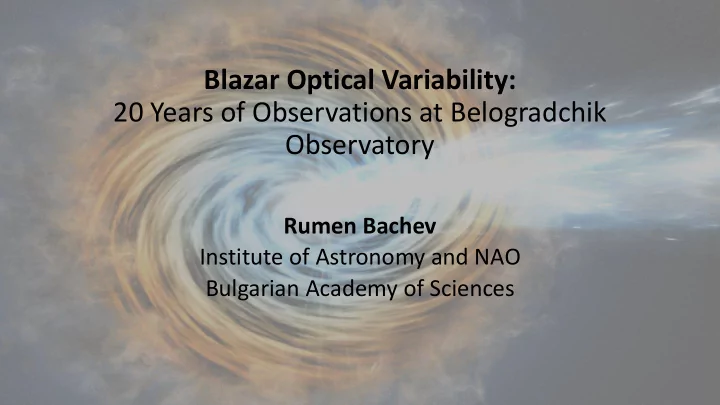

Blazar Optical Variability: 20 Years of Observations at Belogradchik Observatory Rumen Bachev Institute of Astronomy and NAO Bulgarian Academy of Sciences
Blazars are a special type of AGN • The term “blazar” was introduced 40 years ago • Strong (and often – “superluminal”) radio -jets • SED covering from radio to TeV energies • Fast and significant variations at all energies/wavebands • Residing mostly in early-type galaxies • Blazars – natural accelerators to VHE, where new/old physics can be tested
A typical AGN: - Central SMBH - Powered by accretion - Axisymmetric structure - Jets not always present - A blazar – when the jet is aligned with the line of sight (from Beckmann & Shrader, 2013)
Blazar SED (2 broad peaks) : - Synchrotron peak : optical emission (radio to UV/X rays) - Inverse Compton (SSC/EC) peak : gamma rays (MeV to TeV energies)
Emission mechanisms: • Synchrotron emission is highly • (Inverse) Compton photon source: beamed for the relativistic case - Synchrotron photons (SSC) - External photons (EC) from the accretion disk, broad line region, etc.
Blazar optical (synchrotron peak) variability: long-term (from Bachev, 2018)
Blazar optical variability: short-term (CTA 102 example) (from Bachev et al., 2016)
Explaining blazar fast variability • Fast changing Doppler beaming factor (curved jet)? • Fast electron energy-density evolution (acceleration/energy losses)? • Microlensing? • Tests: - Time delays between light curves - Time asymmetry of the light curves - Simultaneous monitoring at different energies/wavebands - Model comparison
Explaining blazar fast variability: Changing Doppler factor – the best explanation so far 1 Γ(1−𝛾𝑑𝑝𝑡𝜄) ; F 𝑝𝑐𝑡 ∝ 𝐸 3+𝛽 • 𝐸 = • Changing 𝜄 from 4 to 0 degrees can change the observed flux 100 times! (from Raiteri et al., 2017)
Belogradchik observations of blazar variability • Belogradchik: 620m altitude; 60 cm telescope + SBIG ST8 / FLI PL9000 CCD’s; ~150 clear night/ yr (~75 usable) • Blazars observations since 1998 (more actively after 2008) • Over 1000 single BVRI estimates (50+ objects) + over 500h of monitoring • Collaborations: India, WEBT, GASP, MAGIC, etc. • 40+ publications (ApJ, A&A, MNRAS, Nature) on blazar variability with the participation of Belogradchik for the period 2007-2017
Thank you!
Recommend
More recommend